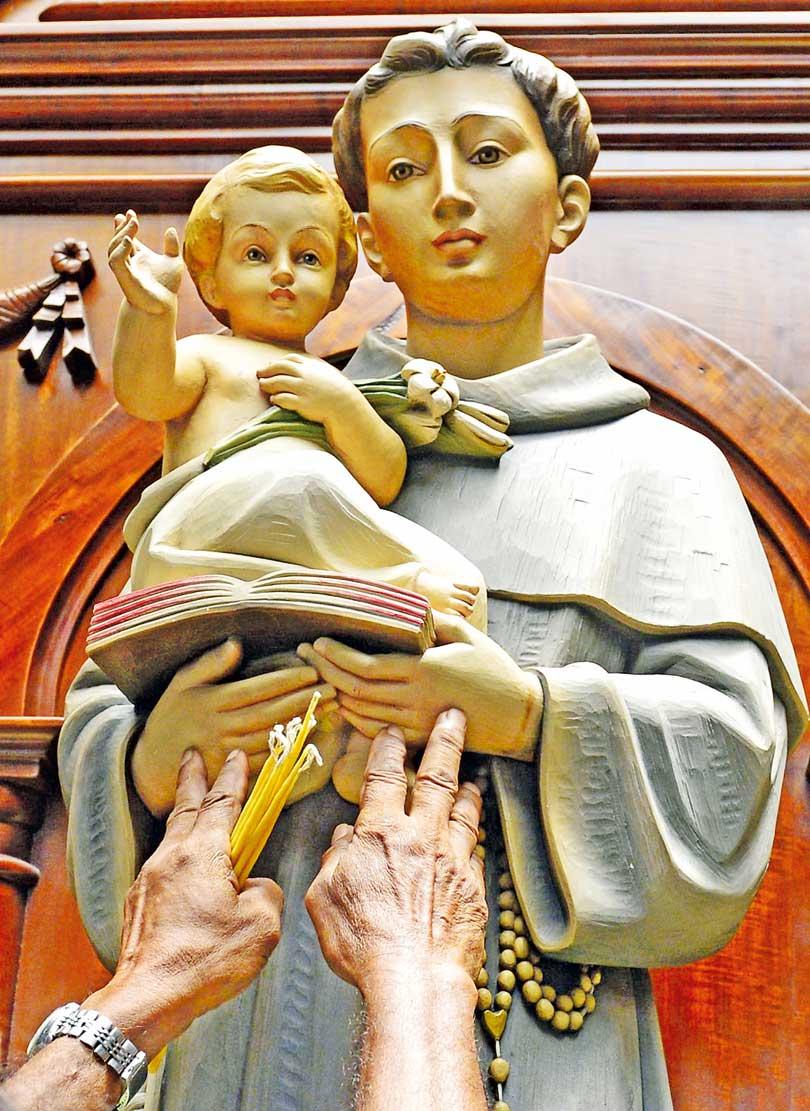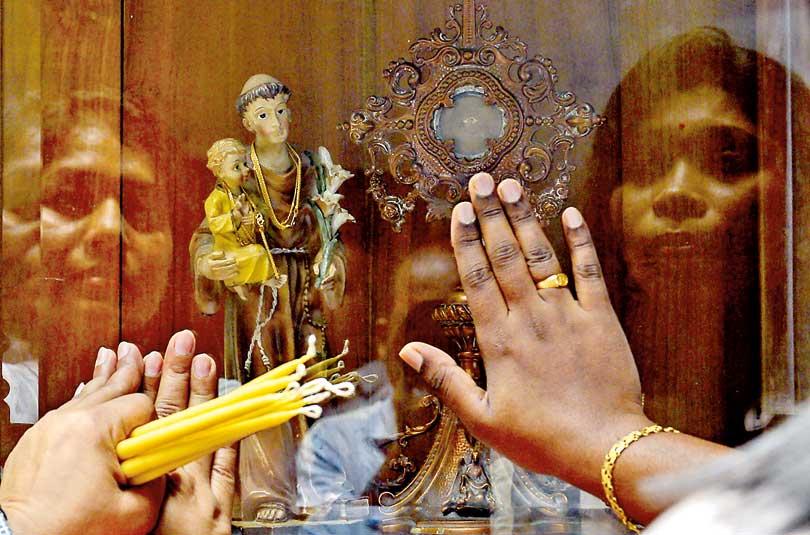12 Jun 2019 - {{hitsCtrl.values.hits}}

Statue of St. Anthony
 In the aftermath of the Easter Sunday bomb blasts where three churches, including St. Anthony’s Church Kochchikade, were attacked, the feast scheduled to be held tomorrow (June 13) has drawn wide attention.
In the aftermath of the Easter Sunday bomb blasts where three churches, including St. Anthony’s Church Kochchikade, were attacked, the feast scheduled to be held tomorrow (June 13) has drawn wide attention.
St. Anthony has over the centuries gained worldwide popularity as ‘St. Anthony of Padua’ as well as ‘St. Anthony of Lisbon.’ It was in Lisbon, Portugal that he was born as Ferdinando Martins de Bulhoes on August 15, 1195. Yet, he worked laboriously for the Lord during the last five years of his short life of 36 years in and from Padua, Italy till his death on June 13, 1231.
The devotion to St. Anthony has spread, like the aroma of Gardenia, across Asia too. He is highly venerated, for example, in our country like a universal Saint, by Christians and non-Christians alike.
All the shrines, churches and chapels dedicated to St. Anthony receive in great numbers devotees, both Catholic and non-Catholic. For these ardent devotees, who may not have travelled to Lisbon or Padua, he is ‘their’ dear Saint, who comes to their aid in their exigencies. Many persons, schools, shops and streets sport names, derived from Anthony. He is never a foreigner, but one of us and a strong link in interfaith chain. Hence he can rightly be called ‘St. Anthony of Sri Lanka.’
How did the Portuguese Saint come to be much invoked in our country? The story traces back to the Portuguese Period of the Sri Lankan History. In 1543, King John III of Portugal sent a band of five Franciscans, with Friar João de Villa do Conde as their leader, to our shores. By the grace of God, they made headway. Thus the Catholic faith was officially introduced into our country.
The cult of Saints was a salient feature of this new faith. The Portuguese missionaries were ever proud of the Saint of their land who had gained so much renown across the globe. He was, furthermore, a Franciscan. Hence the Portuguese Franciscans introduced him, with particular interest, to the forefathers of our faith. Thus the ‘Portuguese Saint’ (i.e. the identification in ancient chronicles) walked through the portals of our land.
As a result, many churches were built in honour of St. Anthony in the maritime provinces where the Portuguese ruled like those at Bambarenda, Aluthgama, Kachchei, Pallansena, Kammala and Weligama. In the chronicle, ‘Conquista spiritual do Oriente’(Spiritual Conquest of the Orient), Friar Paulo da Trindade describes a church at Kotte, dedicated to St. Anthony: “And since they lacked a church where they could hear the word of God and assist at Mass and other divine services, the servants of God made use the famous temple which was there. In this church they taught and they dedicated it to St. Anthony.”
The devotion to St. Anthony has spread, like the aroma of Gardenia, across Asia too
The main Church and the Monastery of the Franciscans in Colombo, which was their headquarters in the Island, were dedicated to St. Anthony. So was the College, attached to the Monastery where the royals like Prince Constantino, Dom Joao of Dom Yamasinghe king of Kandy and Prince Dom Philip Nikapitiye Bandara from Sithawaka received their education.
It was in this Church of St. Anthony in Colombo that King Don Juan Dharmapala was buried in 1597. Trindade records: “That he might no less show his devotion in death, than he had while alive, in the same testament he ordered that his body be clothed in our habit and buried in our church of St. Anthony at Colombo.”
It was also here that the royal family of Jaffna was baptized on June 18, 1623. Among them were Prince Dom Constantino de Cristo, who later became a Franciscan in India and his two sisters, Dona Maria and Dona Izabel, who were the first Sri Lankans to become Catholic nuns.
All these historical facts authenticate the graceful genesis and the gracious growth of a devotion which would last until this day, without being eclipsed by any means. All of them adorn the services the Franciscan missionaries, “the first preachers of the Gospel there”, performed to God, “irrigating with their blood the new plants they planted” (in the language of Trindade) in Ceilao.

This time honoured devotion, we ought to confess, redounds to the honour and glory of God, the source of sanctity. Hence in honouring St. Anthony of Sri Lanka, we honour God, whom he loved to the core. The Saint manifested this love till the end of his life, as we shall see it lastly.
It was June 13 in 1231. The dying Saint was taken on a farm wagon to Arcella near Padua. Having received the Last Rites, the Saint intoned the hymn to the Blessed Mother: “O glorious Queen, exalted above the stars!” His bright eyes gazed ahead. “What do you see?” asked friar Luke. Then the dying Saint, who was about to be counted among the greatest in the holy heavens in the bosom of the glorious Queen, murmured, “I see my Lord.” As a preacher, he constantly preached: “Jesus’ place should always be in the centre of every heart. From this centre, as if from the sun, emanate rays of grace to each of us.” Thus emanated, at the climax of his short, but sweet life, the rays of the Beatific Vision.
(The author, a former director of the faculty of theology at Aquinas University College, did much research to ensure the accuracy of this article)
25 Apr 2024 2 hours ago
25 Apr 2024 2 hours ago
25 Apr 2024 3 hours ago
25 Apr 2024 3 hours ago
25 Apr 2024 4 hours ago